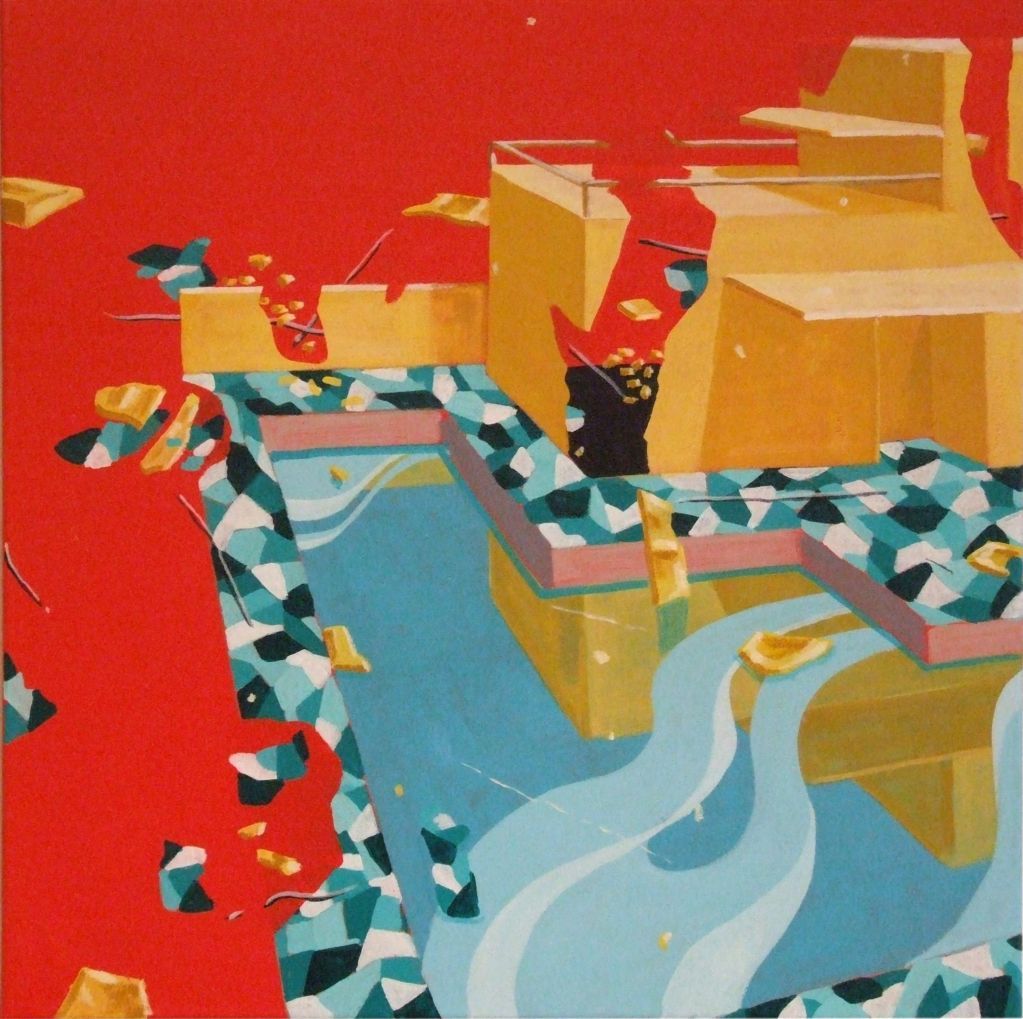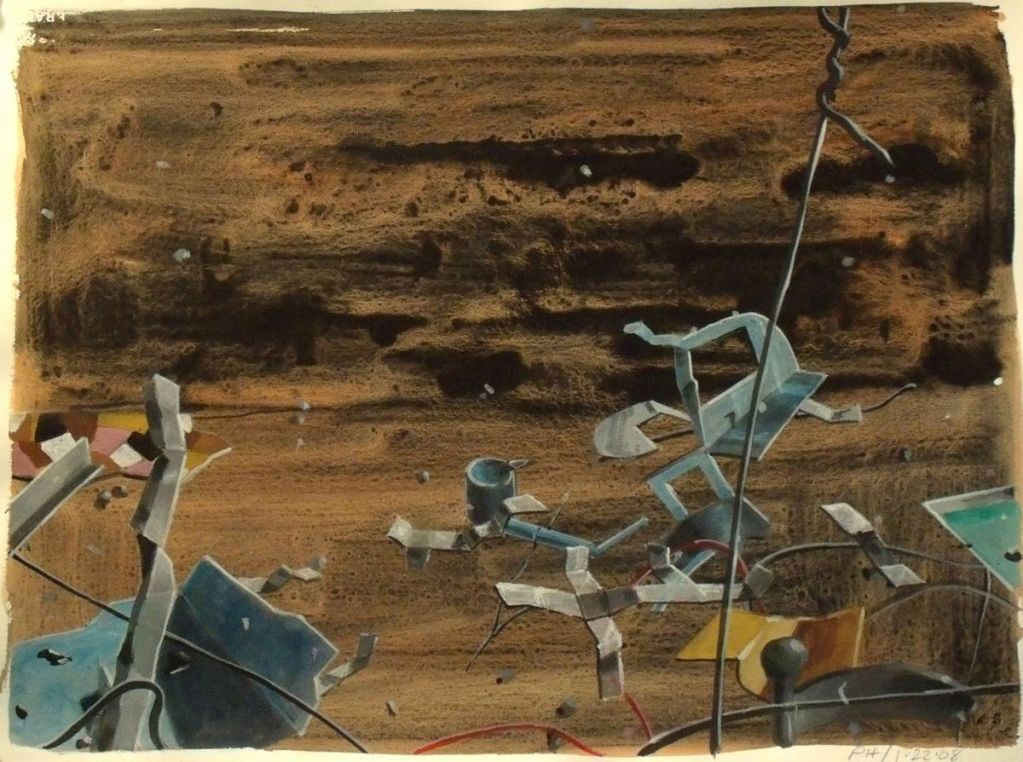“Richard Stout is sweet. He called to tell me he’s going to miss my opening because he’ll be in Rome. I told him fuck you. Did you know my first art class was at a small mom and pop school across the street from Richard’s house? It was the Texas Academy of Art. I didn’t know Richard then, it was 1963.
At this point in my studio visit, Perry and I are talking about “the old days.”
“I can’t drive in front of what used to be the 11th Street Café without thinking about Lucas and Don and Dick. We met there every day, I mean every day. We drank a lot of beer, talked a bunch of b.s. We also talked about art. Lucas would talk about Mexico, and Don about the art scene in London, and Dick, well Dick was Dick. Mostly we talked about women.
It’s weird, Lucas quit smoking and drinking, Wray quit, the others quit smoking and drinking, and they’re all gone, and I’m still here, smoking and drinking. But remember I was 10 years younger (b. 1943). When I did my “Southern Dinner” series and I painted fish on those distorted bowls. That was for Lucas, because he loved to fish – did you know Lucas died fishing?”
Well yes, possessing a tiny bit of knowledge about Houston artists, I knew Lucas Johnson died fishing. Let’s turn to the topic of influence. Was his art impacted by the years he spent with Lucas, Don Foster and Dick Wray? “Well only in one way,” Perry said. “Everybody was working big, so I thought, I’ll work big. So now I have a lot of big paintings.” He pointed to large canvases stacked against the wall.
Perry gave me a tour of the living space above his studio. There are artworks in the small kitchen and also a few framed articles about him. One glossy mag published an image of a collector’s fancy living room decorated with Perry’s triptych The Fountain - The Dead Tree - The X-House, but incorrectly attributed the painting. In his bedroom he pointed to an antique head board that framed the bed in which his daughter was born. The head board is one of the recurring pieces of iconography in his art. Another repeated motif is the broken pearl necklace. It’s from a memory of pearls breaking during teenage car sex, and he employs it to alliterate transience.
And back downstairs he showed me some of his student works from around 1969, the earliest output he considered “successful.” These were made at the California College of Arts and Crafts in Oakland where Perry finished his MFA in 1971. Hippie-dippy Berkeley in '69 must have been um, memorable. Perry’s grin speaks nostalgia and amazement, and then he reflected on the tasteless studio building in which he painted. “There were Hells Angels on one side and Black Panthers on the other.”
How did the Texas boy get to California? It was after his military service, during which he worked design jobs, and devoured art publications. “I was in the library looking at university catalogs, and someone on the opposite side of the bookshelf pushed some books, and the Berkeley catalog fell into my hands.” But prior to entering a university art program, there was a distinctly transformational moment. “It came when I viewed the Phillips Collection. When I saw that I knew I would be a painter.”
Perry taught at Cal State in Bakersfield until the mid-seventies when he returned to Houston. The decision to return was made after reading an Art in America article that described Houston’s vibrant art scene as one in which an artist could actually survive. For 40 something years he has been making art and teaching.
Teaching was necessary. Perry did not have the personality to act available and kiss up to collectors. “I had no ability to aggressively chase money so I had to teach. Playing up to collectors can feel awful, the things we have to do to sell paintings can be nasty business.” Through the years he taught at Glassell, the Art Institute, and Houston Community College.

Photo of Perry House by Casey Williams, 1996
“Did I tell you I got fired from Contemporary Art Museum for fighting with Rolf Westfall?” After returning to Houston, Perry worked for a short while for Jim Harithas at CAM as a museum assistant. One day Westfall pissed him off, “so I slugged him. We fought and I was fired.” The time spent around Jim Harithas though was revelatory. Jim did pain in the ass things like make the staff re-paint an entire gallery until the color was precisely the shade he had in mind, but his presentation was impeccable. “I’ve never seen anyone install a show as well as Jim.”
In Houston he began to have regular exhibitions. Barbara Rose and Susie Kalil included him in the 1985 Fresh Paint: The Houston School at the MFAH, where his art is in the permanent collection. Kalil mounted a solo exhibition at Diverse Works. There were shows at the Art League and Lawndale, and several at the Glassell.
And he gained gallery representation. The Graham Gallery gave him an exhibition, so did Robison Gallery, he had numerous years with Davis and McClain when they partnered, he showed at Betty Moody, at McMurtrey, and at Inman. His most recent alliance is with gallerist Dan Allison. Exhibition exposure stretched to other Texas cities, as well as to Los Angeles, Kansas City Missouri, New Orleans and New York.

Perry House, Untitled, Acrylic on Canvas, 1983 (courtesy Nau-Haus)
As one would expect, his exhibitions elicited critical commentary. Newspaper critics Mimi Crossley, Susan Chadwick and Patricia Johnson covered him, and he was reviewed in Art Lies and ArtPapers. Art critic Tom Moody wrote insightfully about him in blog reviews and in Art Forum. In discourse about a multi-panel piece from the 70s, Moody proclaimed it “Di Chirico-esque in mood.” He called another piece “classically surreal” and went on to say, “at the risk of sounding like ad copy, no one in Houston (or anywhere) does work quite like this.”

Perry House, untitled, acrylic, early 70s (courtesy of Tom Moody)
Moody found his brushwork distinct. “The paintings are done in acrylic. House has a technique of layering washes of thinned out black over a finished image to give a kind of fractal scrim livening up the paint's inherent flat inertness. It's kind of an artificial aging patina but has nothing to do with making it look old--just more complex.”
In the center of the studio is a load bearing stud with a sheet of discolored paper nailed to it. Years ago Perry wrote on it the words “sectioned,” “distorted,” “exploded.” Major categories within his oeuvre intimate these notions.
Abstract paintings in the “Explosion” series have forms that are fractured and distorted. Some of the elements are recognizable and some are not. He said he began the “Explosion” series after the Oklahoma City bombing. “I watched coverage on television and saw that crumbled façade. The paintings are an important metaphor for life’s impermanence.”
The “Happyville” series mutated from the “Explosions.” “Happyville’s” more readable architectonic forms are similarly fractured and exploded. During our discussion about “Happyville” Perry opened his studio door and pointed to his neighbor’s house. “I looked at that house and wondered what would happen if it exploded and had Walt Disney colors.” That was in 2008. Terrorism was on his mind, “you know we’ll be attacked again, nothing’s going to stop that,” and so was the mortgage crises, “all of those upside down houses.”
Driving series such as “Explosion” and “Happyville” is a thorny incongruence. The art is directed by two imperatives - elegance and violence. And you can also find those two words scribbled on the discolored paper nailed to the stud. “There’s something beautifully sculptural and elegant about terrorism.”

Perry House, from the Happyville Series, 2008-2009, Acrylic on Canvas

Perry House, from the Happyville Series, 2008-2009, Acrylic on Canvas
“ArtForum called me a good colorist. The fact is I’m not very aware of color. I focus on value, what’s needed to make forms recede.” Well perhaps, but “Happyville’s” shrilly pastels sublimate violence.
There are forms in “Happyville” that refashion the irregular patterning of terrazzo, marble chips set in cement. European travel accounts for this. In 2009 Perry had a lengthy stay in Rome. He showed me photographs he took of terrazzo covered walkways near Santa Maria Maggiore. Rome’s abundant mosaics also inform his art.
On another trip he spent time in Cordoba’s Great Mosque, and anyone who has seen that inexpressible expanse of marble, granite and onyx columns hoisting red and white striped archways can easily understand how such a thing would permeate his sense of perspective. “I incorporated depth after seeing those arches, a second epiphany like seeing the Phillips Collection.”

Perry House, from the Happyville Series, 2009, Acrylic on Canvas
Also dismembered and exploded are the forms in the “Helter-Skelter” series, which reaches further into the dark and ominous. Its forms are “agitated,” Tom Moody detected.

Perry House, 7-20-09 from the Helter Skelter series, 2009, acrylic on Arches Aquarella, 22x30 (courtesy of Dan Allison)

Perry House, from the Helter Skelter Series, 2011, Acrylic on Canvas
“Of the forty something paintings Kalil put in the Diverse Works show, five were ‘Explosions’ and all the rest were ‘Innards’,“ Perry said, informing me of yet another series. “Innards” were abstractions inspired by body fluids, “inside and out, guts, blood, piss, cum,” he decorously elaborated. He also showed me an abstraction from the “Intrusion” series. It was a lovely canvas with overwhelmingly static blue rectangular bands in the foreground and sinuous organic a-tonal forms in the background. I saw paintings from the “Ship of Fools” series, and from the “Southern Dinner” series, that’s the one with Lucas Johnson’s fish.
As we ended our studio visit I asked Perry how he described his art. “I consider myself an abstract painter. I don’t approach abstraction through design, it comes out of content. Some of my abstraction remains closely and visibly tied to objective reality.”
“Perry House: Elegance/Violence” opens at the Art Car Museum on Saturday June 2, with an opening reception at 7-10pm. “It’s not a retrospective,” he said, “because it won’t have art from the 60s and 70s. The art only goes back to 1983. I can’t even call it a 30 year survey because it only has about 20 percent of my work. They carried out 60 something paintings, and hung it and it was too crowded. Some of my paintings are too big. So Jim Harithas came in, and re-hung the show. Jim removed 13 paintings, and now it looks great.”

Perry House, from the Helter Skelter Series, 2011, Acrylic on Canvas

great article love Perry's work.
ReplyDeleteAn impeccable review about one of the finest painter in the region. Perry opening portrait slide is what too many remember about his attitudes. He is to be reckoned with as a classic Content Abstractionist, having provided innumerable hours of instructional encouragement to many many students.
ReplyDeleteThank you, Robert, for this indepth studio visit preceding his show June 2.
I believe I gave Perry his first show in Houston at U. of St. Thomas in the very early 70s. It consisted of men's hats cut in half and painted, hanging on the walls. Keep painting Perry.
ReplyDelete